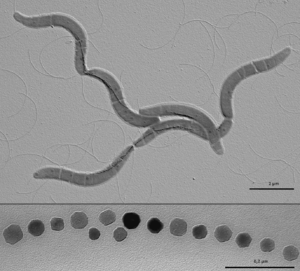Magnetospirillum gryphiswaldense
| Magnetospirillum gryphiswaldense | ||||||||||||
|---|---|---|---|---|---|---|---|---|---|---|---|---|

Magnetospirillum gryphiswaldense . Electron microscope image of some cells with intracellular chains of magnetite crystals. Below: Enlarged section of a crystal chain. |
||||||||||||
| Systematics | ||||||||||||
|
||||||||||||
| Scientific name | ||||||||||||
| Magnetospirillum gryphiswaldense | ||||||||||||
| Schleifer et al. 1992 |
Magnetospirillum gryphiswaldense is a gram-negative , agile and microaerophilic alpha proteobacterium . The cells are spirally wound and simply flagellated in a bipolar manner . M. gryphiswaldense is one of the magnetotactic bacteria that are defined by their abilityto crystallizeintracellularly nanoparticles from magnetite or greigite and use them to align themselves with the earth's magnetic field.
Habitat, Discovery and Isolation
M. gryphiswaldense is a common inhabitant of the upper sediment layers of standing or slowly flowing fresh water. The bacteria prefer environmental conditions with low oxygen concentrations. They are therefore to be found at the transition from the oxic to anoxic sediment zone ( oxic-anoxic transition zone, OATZ ). Aerobic conditions are tolerated at least for a short time.
The organism was first found in the sediment of the river Ryck near Greifswald (name), brought into pure culture and described in 1991. The new genus Magnetospirillum and its type species M. gryphiswaldense were recognized in 1992.
Magnetotaxis
Like all magnetotactic bacteria, M. gryphiswaldense forms specific organelles in which inorganic iron minerals crystallize through controlled biomineralization processes . The organelles are called magnetosomes and are vesicles about 50 nm in diameter that are pinched off by the inner cell membrane. Inside the vesicle, conditions are created that allow the iron oxide to crystallize. In addition to a suitable pH value, this also includes a high concentration of iron ions, which are introduced through directed transport processes. The cubooctahedral magnetite crystals grow to a defined size of about 45 nm in diameter. Such a size control is important because crystals that are too small or too large cannot develop a stable or identically aligned magnetic moment (single-domain crystals, Weiss domains ). The magnetosomes are also arranged in a chain along the cell axis by special cytoskeletal proteins. This ensures that the magnetosomes in the cell do not clump together due to magnetic interaction, but are lined up and act like an intracellular bar magnet. This aligns the cell with the earth's magnetic field like an internal compass needle. It is believed that in this way the cells can move more specifically and find their preferred environmental conditions more quickly.
research
M. gryphiswaldense is one of the few magnetotactic bacteria that can be cultivated and genetically manipulated in laboratories. The processes of organelle formation, biomineralization, cell division and magnetotaxis are the subject of current basic research. In addition, isolated and modified magnetosomes are used in interdisciplinary research because of their special properties, which are often superior to those of artificially produced magnetite particles.
further reading
- Jogler, C., and D. Schüler. 2009. Genetics, genomics, and cell biology of magnetosome formation in magnetotactic bacteria. Annu. Rev. Microbiol. 63: 501-521.
Databases
- LPSN , keyword "Magnetospirillum" - http://www.bacterio.net/magnetospirillum.html
- NCBI , Taxonomy browser, keyword "Magnetospirillum gryphiswaldense" - https://www.ncbi.nlm.nih.gov/Taxonomy/Browser/wwwtax.cgi?id=55518
Individual evidence
- ^ KH Schleifer, D. Schüler, S. Spring, M. Weizenegger, R. Amann, W. Ludwig, M. Köhler: The Genus Magnetospirillum gen. Nov. Description of Magnetospirillum gryphiswaldense sp. nov. and Transfer of Aquaspirillum magnetotacticum to Magnetospirillum magnetotacticum comb. nov. In: Systematic and Applied Microbiology . tape 14 , no. 4 , October 1991, p. 379-385 ., Doi : 10.1016 / S0723-2020 (11) 80313-9 .
- ↑ IUMS : Validation of the publication of new names and new combinations previously effectively published outside the IJSB. List No. 40. In: International journal of systematic bacteriology. Volume 42, Number 1, January 1992, pp. 191-192, doi: 10.1099 / 00207713-42-1-191 , PMID 1736967 .